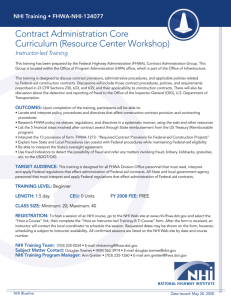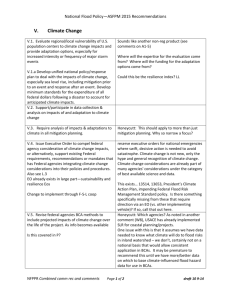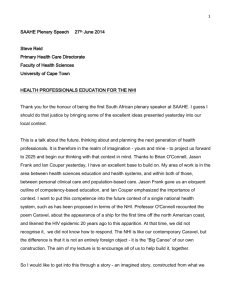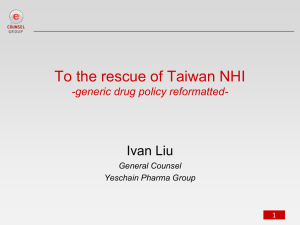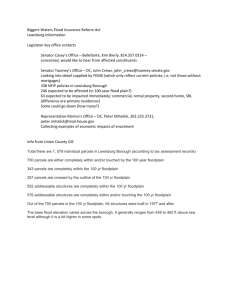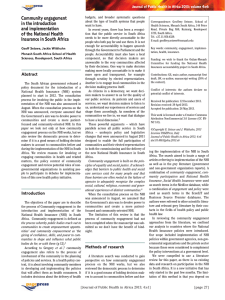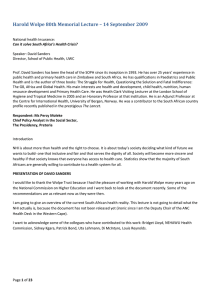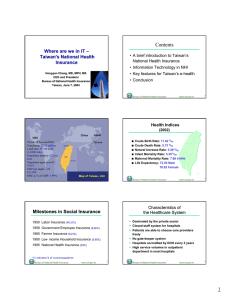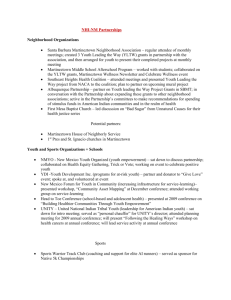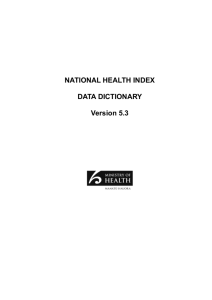Water Storage Innovation for Climate Adaptation and River
advertisement
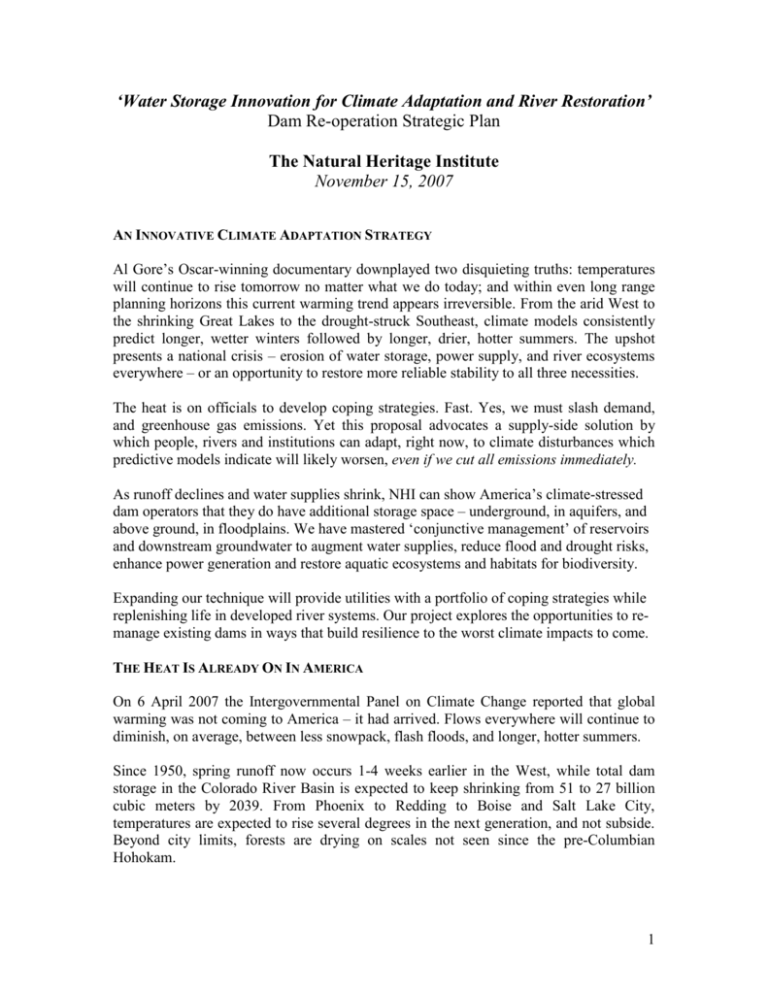
‘Water Storage Innovation for Climate Adaptation and River Restoration’ Dam Re-operation Strategic Plan The Natural Heritage Institute November 15, 2007 AN INNOVATIVE CLIMATE ADAPTATION STRATEGY Al Gore’s Oscar-winning documentary downplayed two disquieting truths: temperatures will continue to rise tomorrow no matter what we do today; and within even long range planning horizons this current warming trend appears irreversible. From the arid West to the shrinking Great Lakes to the drought-struck Southeast, climate models consistently predict longer, wetter winters followed by longer, drier, hotter summers. The upshot presents a national crisis – erosion of water storage, power supply, and river ecosystems everywhere – or an opportunity to restore more reliable stability to all three necessities. The heat is on officials to develop coping strategies. Fast. Yes, we must slash demand, and greenhouse gas emissions. Yet this proposal advocates a supply-side solution by which people, rivers and institutions can adapt, right now, to climate disturbances which predictive models indicate will likely worsen, even if we cut all emissions immediately. As runoff declines and water supplies shrink, NHI can show America’s climate-stressed dam operators that they do have additional storage space – underground, in aquifers, and above ground, in floodplains. We have mastered ‘conjunctive management’ of reservoirs and downstream groundwater to augment water supplies, reduce flood and drought risks, enhance power generation and restore aquatic ecosystems and habitats for biodiversity. Expanding our technique will provide utilities with a portfolio of coping strategies while replenishing life in developed river systems. Our project explores the opportunities to remanage existing dams in ways that build resilience to the worst climate impacts to come. THE HEAT IS ALREADY ON IN AMERICA On 6 April 2007 the Intergovernmental Panel on Climate Change reported that global warming was not coming to America – it had arrived. Flows everywhere will continue to diminish, on average, between less snowpack, flash floods, and longer, hotter summers. Since 1950, spring runoff now occurs 1-4 weeks earlier in the West, while total dam storage in the Colorado River Basin is expected to keep shrinking from 51 to 27 billion cubic meters by 2039. From Phoenix to Redding to Boise and Salt Lake City, temperatures are expected to rise several degrees in the next generation, and not subside. Beyond city limits, forests are drying on scales not seen since the pre-Columbian Hohokam. 1 Yet climate impacts are not unique to the West. In 2002 abnormally dry conditions desiccated all or part of 49 states; in 2006, 57 America’s rivers shrank to record lows. The Great Lakes stand seven inches below historic levels. Southeastern drought cut Tennessee Valley Authority hydropower in half, forced Alabama, Florida and Georgia to fight over dwindling federal reservoirs, and left Atlanta – America’s fastest growing city and home to UPS, Delta and Coca-Cola – with ninety days of water. AUGMENTING SUPPLY WITHOUT NEW INFRASTRUCTURE To endure and thrive, natural biological systems will need as much help from human ingenuity as is possible. This proposal focuses its energies on harnessing proven approaches to river adaptation. In July 2007 State Water Authorities warned how the severe drought that began in 2000 “served as a wake-up call to water utility managers regarding the possible implications of global warming.” Public and private water and power supply entities have acknowledged the reality that global warming will affect the reliability of these aquatic systems and will affect them radically. Rather than wait for better predictive models to emerge, they see the menace of radical climate change hurting their operations, now, and seek to develop measures to cope with it. The question is how. Most plant managers and officials try to adapt by reducing pressure on their operations by reducing demand. In a state of emergency, Georgia banned outdoor water use while Tennessee towns cut off household water 21 hours per day. TVA, BPA and other utilities from the Colorado Basin to the Atlantic Seaboard were forced to reduce hydropower generation. Extreme sacrifice helps mitigate parts of the issue, but rarely solve the entire equation. NHI augments conservation strategies with approaches that improve people and nature by adapting water supplies. Supply side adaptation has been long neglected by agencies, foundations and activists because many parties feel they lack effective, durable options. Most see ‘supply side’ as a euphemism for either pouring more concrete walls, tapping natural lakes or mining fossil aquifers. In fact, the best supply side adaptation involves no new dams or pumps. NHI proposes new, but proven, technically sophisticated approaches. We work with natural systems rather than against them. By linking surface flows with groundwater and floodplain storage, we improve the flexibility and efficiency of existing infrastructure to improve, or do away with the need for, new potentially damaging projects. PROVEN SOLUTIONS IN AN AGE OF SCARCITY Climate change makes water and hydropower-dependent utilities face unprecedented extreme weather. Severe weather triggers a chain reaction: water managers must operate dams conservatively in the face of radically altered rainfall and runoff patterns; cautions to absorb potential floods make them lower reservoirs; lowered reservoirs then receive less runoff during protracted droughts; and longer, hotter droughts more rapidly evaporate what runoff can then be captured. The vicious cycle reduces the supply of two precious resources – power and water – most increasingly in demand. 2 Since 1989, NHI has restored water resources by developing innovative solutions founded upon cutting-edge scientific, legal and policy analysis. Our hydraulic modelers, ecologists, fishery biologists, resource economists and planners work in concert to improve decisions, optimize water, and preserve the aquatic ecosystems on which humans depend. NHI operates domestically with particular emphasis on heavily developed and stressed river systems. In California, NHI has pioneered techniques to link groundwater banks with dams to improve water supply, flood management, and river flows synergistically. We are now integrating the largest Federal reservoir at Lake Shasta, the largest State reservoir at Lake Oroville, and the groundwater underlying both. Such ‘conjunctive management’ secures supplies, eliminates risks, and restores habitats. California is not America, and each stream is as unique as a snowflakes. But global warming alters runoff and water storage systems in common patterns; these climatedriven patterns have led others to our door. Arizona water managers asked NHI to help reconcile competing water rights, new demands, and increasingly reduced storage. Washington utilities want to learn from our experience. Colorado’s State officials seek our help “to attack both sides of the supply-demand equation when faced with more variable water supply due to global warming.” The Bureau of Reclamation has reached out to us for adaptive strategies on federal water infrastructure. A RESOURCE PORTFOLIO TO ADAPT SUPPLIES As one Western water manager explained: “In this age of scarce water supplies, the prospect of climate change should serve as a catalyst for paradigm shifts in the way we manage water. To cope with these changes effectively, water utilities will need to act quickly to develop diverse and flexible water resource portfolios that will allow them to reduce demands; and adapt their supplies to changing climatic and hydrological conditions [emphasis ours].” Our project sets out to accomplish both goals together. NHI’s proposal to develop a water resource portfolio for supply adaptation is more than a paper study. We propose to: 1) select the most fitting and appropriate sites that span the variety of hydrology, climate, and water systems throughout America for detailed examination; 2) investigate the technical feasibility of incorporating environmental restoration into climate change adaptive strategies; and 3) help our collaborators implement these concepts through the FERC hydropower relicensing process; utility rate reforms; revenue bonding mechanisms; and flood management policy reforms. NHI’S THREE-STAGE WORK PLAN Based on our experience, this project explores technical feasibility studies that include the engineering, economic, environmental and legal/institutional parameters. It then demonstrates pilot scale experiments in a variety of settings that span the spectrum of hydrology, climate, and water systems. The overall aim builds resilience into river systems, and to demonstrate tools and techniques for broader application. 3 Stage One: select sites for detailed examination. Conduct a series of consultations with promising water and power supply agencies, based on: river systems with multiple purpose reservoirs that are operated for power or water supply and flood control; irrigation projects that include a groundwater system that can be utilized to augment storage; hydropower dams that face imminent FERC relicensing; a re-habitable floodplain that faces imminent development pressures downstream of a dam. Select the three most vulnerable and appropriate study sites, representing a range of hydrologic conditions or water and power supply and demand situations in America. Stage Two: investigate technical feasibility. Develop an aquatic ecosystems restoration concept that can be incorporated into the emerging water or power augmentation plans of the collaborating agency. We will develop (or utilize and apply an existing) water systems operations model, or suite of models, to develop and evaluate the restoration concept and estimate its economic costs and benefits. Because of the water and power supply benefits of these concepts, we expect the environmental enhancements to actually produce a net positive economic benefit. The feasibility investigation involves: technical (hydrologic and engineering), economic, and legal/institutional analysis. Stage Three: implement the strategy. This is not a paper study. The project will continue through the implementation of the concept. NHI will work with the water or power supply collaborators to facilitate the implementation by pressing its inherent advantages: (1) expedited pathway through the environmental assessment and permitting process, (2) access to public financing, (3) incorporation of the costs of climate change adaptations in the rate base (if a regulated utility), or in the appropriation process (if a public agency). More specifically, NHI will champion and advance this climate adaptation and environmental restoration strategy – both the particular collaborations and the general policies – opportunistically in regulatory and planning processes such as: FERC Hydropower Relicensing Process: FERC and applicants needs to consider operating dams to improve power reliability as the hydrology of these systems changes with climate. NHI will advocate reforms that require hydropower facilities to finance flood-accommodation actions in the downstream floodplain that will allow the hydropower facility to release more naturalized flows. This is a major paradigm shift from conventional “minimum in-stream flows” to variable out-of-stream flood events that reconnect and revive the floodplain. If the floodplain is undeveloped, actions may involve purchasing easements from riparian landowners. If the floodplain is substantially developed, it may involve buying out and relocating structures or farmlands cultivating permanent crops. Any interventions would be collaborative, not adversarial. Rate Reform: States subject private hydropower and water supply companies to rate regulation. If they could pass on to customers the costs and benefits of investing in supply augmentation – treating the floodplains and aquifers as an expanded natural reservoir for more reliable and efficient water and energy supplies – it would constitute a powerful economic incentive to undertake these climate adaptive and environmental restoration initiatives. Also, the adaptive and 4 restorative re-operation of dams that we contemplate will move power production from low inflow periods to high inflow periods. To implement these principles, NHI will selectively and strategically intervene in rate proceedings on behalf of the water or power company to advocate this novel rate reform. Revenue Bonding Mechanisms: Because these climate adaptation and environmental restoration initiatives will generate incremental revenues for the purveyors, it is possible to devise revenue bonding mechanisms that will allow these entities to finance system improvements with tax-free bonds. Bond underwriters are not yet familiar with this type of enterprise, because it has not yet been presented to them in a convincing way. But through the types of collaborations envisioned, NHI can take the lead in promoting this type of innovative financing technique. Power companies use flood plain storage to meet flood management responsibilities; they maintain higher storage levels in the reservoir; create higher hydraulic head; generate more power; earn more revenues. Flood Management Policy Reform: The U.S. Army Corps of Engineers Reservoir dictates operations for flood control, while the Federal Emergency Management Agency conforms regulations to floodplain mapping. Meanwhile, floodplain land use planning and regulation is carried out by local government in the American West. NHI will educate these agencies about how to use the floodplain to simultaneously reduce flood risks, buffer climate change effects, and restore ecological functions until it becomes part of the regulatory calculus of these agencies. Such reforms are best accomplished through specific water and power supply augmentation plans, promoted in collaboration with water and power agencies, with NHI representing environmental interests. 5


